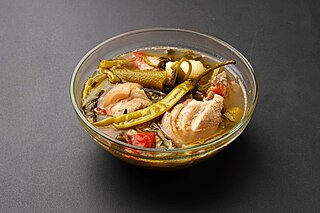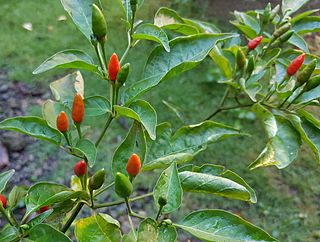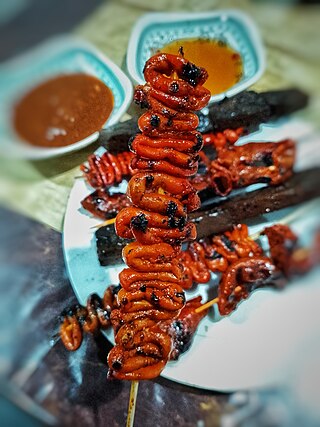
Vinegar is an aqueous solution of acetic acid and trace compounds that may include flavorings. Vinegar typically contains from 5% to 18% acetic acid by volume. Usually, the acetic acid is produced by a double fermentation, converting simple sugars to ethanol using yeast and ethanol to acetic acid using acetic acid bacteria. Many types of vinegar are made, depending on source materials. The product is now mainly used in the culinary arts as a flavorful, acidic cooking ingredient or in pickling. Various types are used as condiments or garnishes, including balsamic vinegar and malt vinegar.

Adobo or adobar is the immersion of food in a stock composed variously of paprika, oregano, salt, garlic, and vinegar to preserve and enhance its flavor. The Portuguese variant is known as carne de vinha d'alhos. The practice, native to Iberia, was widely adopted in Latin America, as well as Spanish and Portuguese colonies in Africa and Asia.

Argao, officially the Municipality of Argao, is a 1st class municipality in the province of Cebu, Philippines. According to the 2020 census, it has a population of 78,187 people.

Sinigang is a Filipino soup or stew characterized by its sour and savory taste. It is most often associated with tamarind, although it can use other sour fruits and leaves as the souring agent such as unripe mangoes or rice vinegar. It is one of the more popular dishes in Filipino cuisine. This soup, like most Filipino dishes, is usually accompanied by rice.

Tapa is dried or cured beef, pork, mutton, venison or horse meat, although other meat or even fish may be used. Filipinos prepare tapa by using thin slices of meat and curing these with salt and spices as a preservation method.

Pancit, also spelled pansít, is a general term referring to various traditional noodle dishes in Filipino cuisine. There are numerous types of pancit, often named based on the noodles used, method of cooking, place of origin, equal and constant diameter or the ingredients. Most pancit dishes are characteristically served with calamansi, which adds a citrusy flavor profile.

The generic term for condiments in the Filipino cuisine is sawsawan. Unlike sauces in other Southeast Asian regions, most sawsawan are not prepared beforehand, but are assembled on the table according to the preferences of the diner.

Banana ketchup, also known as banana sauce, is a Philippine fruit ketchup condiment made from banana, sugar, vinegar, and spices. Its natural color is brownish-yellow but it is often dyed red to resemble tomato ketchup. Banana ketchup was first produced in the Philippines during World War II due to a wartime shortage of tomatoes but a comparatively high production of bananas.

Siling labuyo is a small chili pepper cultivar that developed in the Philippines after the Columbian Exchange. It belongs to the species Capsicum frutescens and is characterized by triangular fruits that grow pointing upwards. The fruits and leaves are used in traditional Philippine cuisine. The fruit is pungent, ranking at 80,000 to 100,000 heat units in the Scoville Scale.

Isaw is a popular street food from the Philippines, made from barbecued pig or chicken intestines. It is a type of inihaw. The intestines are cleaned several times and are then either boiled, then grilled on sticks. For presentability, the intestines are usually applied with orange food coloring. Once cooked, it is usually dipped in vinegar or sukang pinakurat. They are usually sold by vendors on street corners during the afternoons.

Daing, tuyô, or bilad are dried fish from the Philippines. Fish prepared as daing are usually split open, gutted, salted liberally, and then sun and air-dried. There are also "boneless" versions which fillets the fish before the drying process. It was originally a preservation technique, as salt inhibits the growth of bacteria, allowing fish to be stored for long periods of time.

Philippine adobo is a popular Filipino dish and cooking process in Philippine cuisine. In its base form, meat, seafood, or vegetables are first browned in oil, and then marinated and simmered in vinegar, salt and/or soy sauce, and garlic. It has occasionally been considered the unofficial national dish in the Philippines.

Inihaw, also known as sinugba or inasal, are various types of grilled or spit-roasted barbecue dishes from the Philippines. They are usually made from pork or chicken and are served on bamboo skewers or in small cubes with a soy sauce and vinegar-based dip. The term can also refer to any meat or seafood dish cooked and served in a similar way. Inihaw are commonly sold as street food and are eaten with white rice or rice cooked in coconut leaves (pusô). Inihaw is also commonly referred to as Filipino barbecue or (informally) Pinoy BBQ.

Latík refers to two different coconut-based ingredients in Filipino cuisine. In the Visayan region it refers to a syrupy caramelized coconut cream used as a dessert sauce. In the northern Philippines, it refers to solid byproducts of coconut oil production, used as garnishing for a variety of desserts.

Mama Sita's Holding Company, Inc. is a Philippine based manufacturer of condiments, selling its products under the brand, Mama Sita's. The brand is named after Teresita "Mama Sita" C. Reyes, matriarch of the company's founders, the spouses Bartolome B. Lapus and Clara C. Reyes-Lapus.

Balbacua, also spelled balbakwa or balbakoa, is a Filipino beef stew made from beef, collagen-rich beef parts, and various spices cooked for several hours until very tender. It is typically served with white rice or misua or miki noodles. It originates from the Visayan regions of the Visayas and Mindanao islands.

Datu Puti is a condiment brand owned by NutriAsia, Inc.. Datu Puti was first introduced as a vinegar product in 1975 by Hernan Reyes. Eventually, soy sauce and fish sauce under the Datu Puti brand were introduced in the 1990s. An oyster sauce product was also introduced.

Nipa palm vinegar, also known as sukang sasâ or sukang nipa, is a traditional Filipino vinegar made from the sap of the nipa palm. It is one of the four main types of vinegars in the Philippines, along with coconut vinegar, cane vinegar, and kaong palm vinegar. It is usually sold under the generic label of "palm vinegar".
Kaong palm vinegar, also known as irok palm vinegar or arengga palm vinegar, is a traditional Filipino vinegar made from the sap of the kaong sugar palm. It is one of the four main types of vinegars in the Philippines, along with coconut vinegar, cane vinegar, and nipa palm vinegar. It is usually sold under the generic label of "palm vinegar".

Silver Swan is a Filipino condiment brand owned by NutriAsia through subsidiary First PGMC Enterprises, Inc.. It was first introduced as a soy sauce brand in 1942 by Sy Bun Suan. Later on, the brand was expanded to include vinegar, fish sauce, chili sauce and oyster sauce.





















